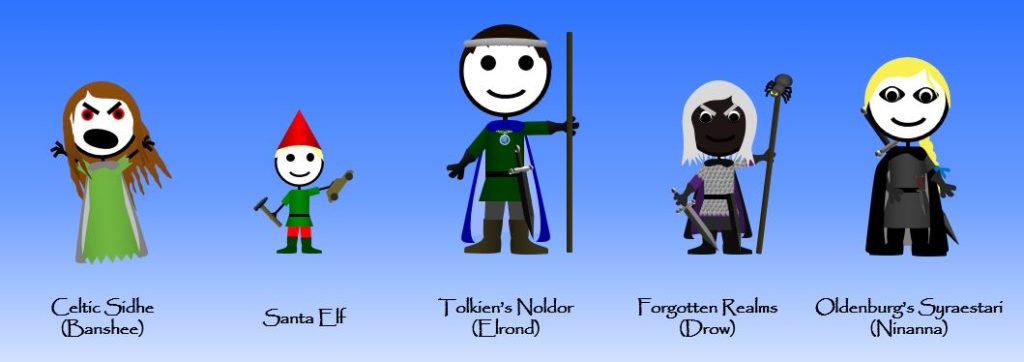One of basic components of fantasy is the blending of the familiar with the fanciful. But sway too far one way or the other and the majority of readers will disengage. After all, it would be very hard to relate to a hero that is a green blob of goo that feeds off of sunlight and procreates through mitosis. Pair it up with a hundred legged centipede with no arms and dozens of eyes and you might have yourself a fine adventure… but protagonists whose goals, ambitions, emotions, and patterns of thought your reader can’t relate to.
On the other hand, stories can go too generic with your peasant boy who is somehow masterful with a sword joining a greedy beer guzzling dwarf warrior, a pickpocketing amoral halfling thief, and a snobbish elven wizard.
So with all that in mind, are the Syraestari fanciful or familiar? Are they ‘just’ another brand of elves?
Yup, they’re my elves, but that doesn’t mean they can’t be both fanciful and familiar.
After all, what does it mean to be an elf? This is actually a lot less clear than one might think.
Dwarves, at least in the last 50+ years, are almost always typecast as short stocky subterranean bearded folk with a relentless greed for gold and an interminably cranky demeanor. But if you say ‘elf’ to someone, a dozen potential images may leap to mind. Perhaps they build toys for Santa at the North Pole… or some poor shoemaker. They might live underground and worship spiders. They might be little people with wings like a fly or they may only be a little shorter than humans. On the other hand, some are tall, possessing an ancient and potent nobility that makes humans look like crude primitives by comparison.
But all these elves tend to fall into one of two categories. They’re either fantastical, otherworldly creatures possessing strange and powerful magic… usually of a chaotic, capricious, or whimsical variety. Or they are more ‘earthly’ humanoids with a culture different but not incomprehensible to our own… but also with a magical flavor often potent but generally more definable.
Amusingly, the two characteristics that seem to be relentlessly present are that elves are lean and have pointy ears. Other than that, though, the variety is astounding.
Probably not surprisingly, the biggest elven influence on me is Tolkien. I’ve never cared for short elves. Elves have always struck me as stately and majestic creatures that are a little bit larger than life… not spritely or small.
I’ve also liked the idea of elves being unaging and not merely long-lived. To be long-lived is to be human and a little bit more. Unaging is a whole different ballgame. Mortality (due to age) is off the table. Along with that goes disease which has been a huge influence on human societal evolution (recommended reading: “Guns, Germs, and Steel” by Jared Diamond). Unaging elves would walk through all that with impunity… COVID-19? For them it would be something to shrug at. Furthermore, unaging opens all sorts of additional avenues when you create the interrelationships of these disease-aging free elves with mortal humans, bergrist, and especially the short-lived ie’dhae.
Perhaps the biggest non-Tolkien influence is the idea, common in Forgotten Realms and other sources, of high and dark elves. Tolkien had both of these, to be sure, but the difference for him was a minor point probably only known to those who have braved “The Silmarillion.” The more modern interpretation is one of two opposing forces, one good and the other evil.
So what sets my Syraestari apart? What makes them interesting?
This, of course, can only be answered by the particular interpretations and inclinations of the reader, but it is my hope that in my Syraestari I have provided something familiar yet also a little different. Next time, we’ll take a look at what those are including delving further into the nature of their longevity, taking a new look at the juxtaposition of high and dark, and exploring the impact of oneness-fractured.
